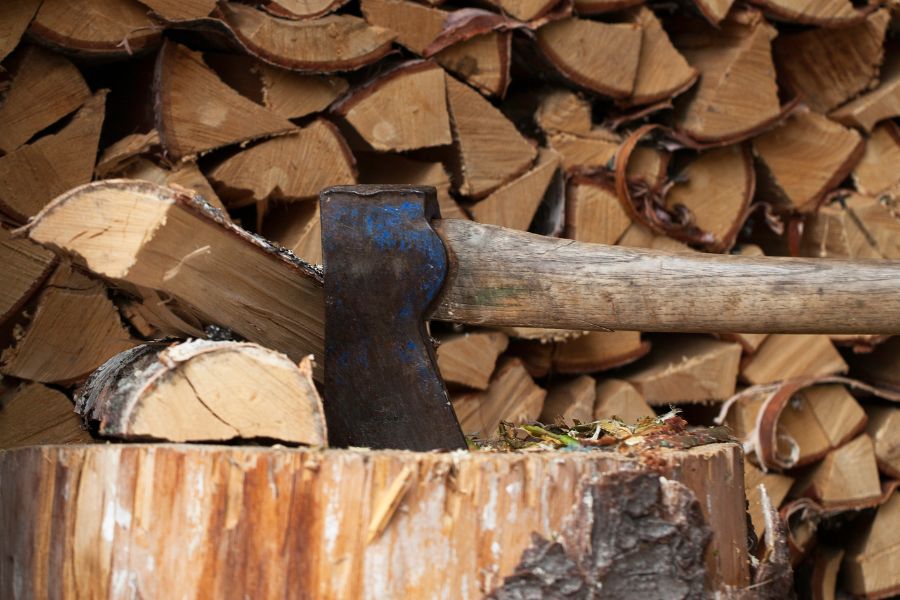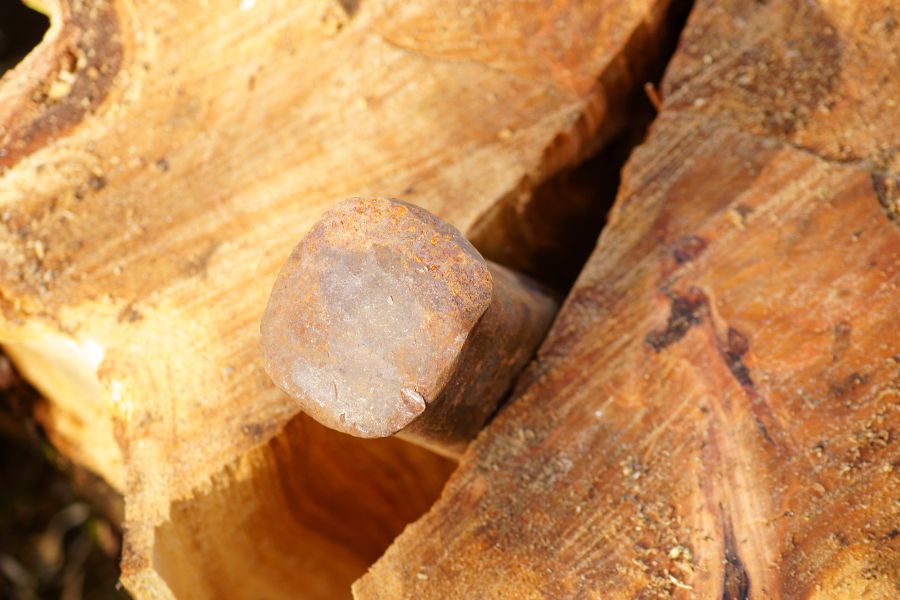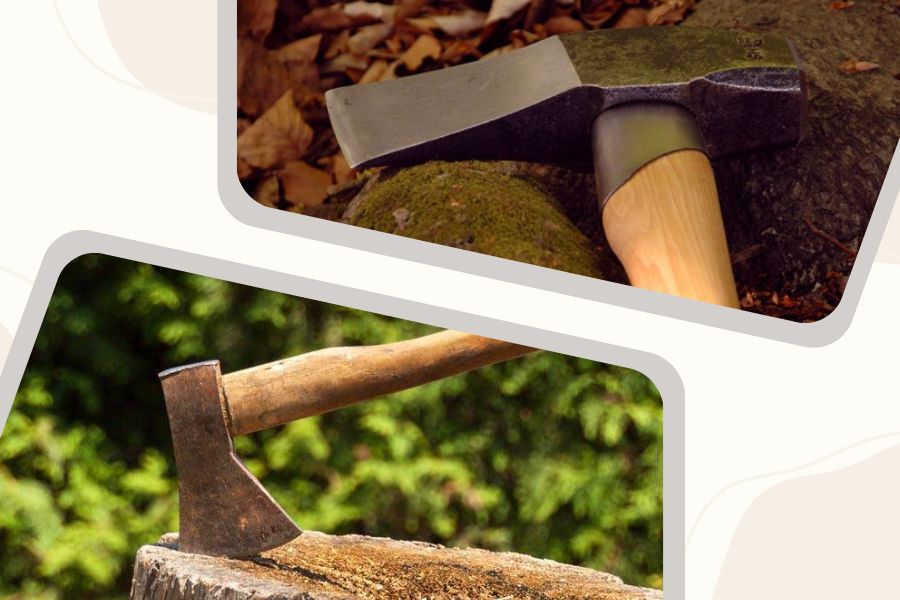Welcome to the art of splitting wood! If you’ve ever wanted to turn a wood log into useful pieces, this guide is for you. You’ll learn about different splitting tools, like the axe, maul, and wedge. Each has a unique role in wood splitting.
A splitting axe handle has a sharp blade for cutting wood. It’s lighter in the head than a maul, which makes it easy to swing. Yet, its sharp edge can split smaller logs with less effort. The handle of a splitting axe can be made from wood or composite material.
On the other hand, a splitting maul has a heavier head. It’s the tool you need when you have larger logs or tougher wood. The heavier hammer side of the splitting maul and the opposite side, a blade, make a huge difference when splitting. A maul axe is a two-in-one tool that can split and cut wood.
The splitting wedge is another useful tool for splitting axes. It’s diamond-shaped and meant to be hit with a heavy hammer or sledgehammer. This tool is excellent for starting the first split in a log.
But choosing the right tool is not enough. You’ll also need to care for your tools. This includes keeping the head sharp and the handle strong. By doing so, you’ll extend the life of your tool and make splitting an easier task.
So, whether you’re using a high-carbon steel splitting axe or a heavy-head maul, remember: splitting wood is more than just a chore. It’s an art, a skill, and a way to connect with nature. So, let’s dive into the world of splitting and learn how to split wood like a pro!
Understanding Wood Splitting: Mauls and Wedges
When you want to split wood, the right tool is essential. We will focus on two main tools: the splitting maul and the splitting wedge. Each one has unique features that make it ideal for specific tasks. Let’s dive in!
Splitting Maul: Heavier Head for More Power

A splitting maul is a heavy-duty tool. It is also called a maul axe or sledge axe. The entire tool is built for power. Its head is made of carbon steel. This metal head is heavier than most, usually between three and six pounds. This heavy hammer-like head is excellent for splitting the toughest woods.
The maul axe is wider than a typical axe. This is known as being wedge-shaped. Its thicker head and edge are not for chopping like an axe. They are designed to split wood logs without getting stuck.
The handle is also unique. It can be made of wood or composite material. It’s longer than on most axes. This gives you more leverage. This makes a difficult task like splitting hardwood easier.
Splitting Wedges: Less Force, More Control

Next up is the splitting wedge. This tool is also for splitting wood. But it’s different than a maul. It’s more of a blockbuster or a block splitter. You use it with a sledgehammer. The hammer strikes the flat, opposite side of the wedge. This forces the wedge into the wood.
A wedge has a thinner head and thinner edge, too. This helps it to cut into the wood easily. It’s made of a diamond-shaped piece of metal, usually high-carbon steel. This gives it a sharper blade and excellent cutting capacity.
Like the maul, wedges can have different handles. Some have wood handles. Others have composite wooden handles. What you pick depends on what you like.
Both these tools, the maul, and the wedge, can be found in hardware stores. They each have their own strengths. Choose the one that suits your needs best. That’s the way to make wood splitting easier!
The Anatomy of Splitting Tools: Head Design and Handles
Understanding the parts of a tool can help us use it better. In splitting tools, like the splitting maul and the splitting axe, two parts are most important: the head and the handle. Let’s learn about them!
Maul Head and Axe Head: Blunt Side, Heavier Head, and Tapered Head

The head is the top part of these tools. It’s the part that does the work when you chop or cut wood. The maul and axe head are a bit different, but both are effective for splitting wood.
A maul axe head is heavier. It’s blunt on one side, like a sledgehammer. This helps to split the wood fibers apart. The other side has a tapered head. This is more pointed and allows the tool to cut into the wood. The edge is thinner than a regular axe. This makes it suitable for splitting, not chopping.
An axe head, on the other hand, is lighter. It’s not as blunt as a maul head. It’s more designed for chopping logs, not splitting them.
Handle Types: From Wood to Composite Handles
The handle is the long part you hold when you use the tool. There are different types for different tools. But in splitting axes and mauls, the two main types are wood and composite.
A wood handle is traditional. It’s what people have used for many years. It’s strong and can last long if you take care of it.
A composite handle is newer. It’s made from modern materials that are strong and light. They can last a long time and don’t need much care.
So, when picking a tool, think about the head and the handle. They both matter a lot. Whether you’re using a log splitter or a diamond wedge, understanding these parts can help you use your tool better!
The Tools in Action: Splitting Logs and Large Rounds
Splitting tools are great for cutting logs. But they’re not all the same. Some splitting axes are better for large logs, and some are better for smaller ones. Let’s see how they work in action!
Splitting Mauls and Axes: For Large Logs and Tough Wood
Think about when you have a big, tough log. It might seem hard to split. But, with a splitting axe maul or splitting axe head, it’s easier! The splitting maul or axe head on these tools is made to cut through tough wood.
The splitting axe handle gives you a lot of control over splitting axes. You hold it with both hands. This way, you can use all your strength to the splitting axe vs chop the wood.
The axe head has a thin edge. This helps it cut deep into the log. The head is also heavy. This gives it more power to split the log apart.
Splitting Wedges: Ideal for Smaller Logs and First Splits
Now, what if you have a smaller log? Or what if you’re starting to split a big log? This is where a splitting wedge comes in handy.
You use a wedge with a wooden handle. You put the thin edge of the wedge into the log. Then, you hit the other end with a hammer. This pushes the wedge into the log. The force splits the wood apart.
A splitting wedge is easier to use than a maul or axe. It’s not as heavy, so it takes less strength. But it still gets the job done!
So, these are two great tools for splitting wood. They each have their own strengths. Choose the one that fits your needs. Then, you’ll be ready to split any log that comes your way!
Head to Head: Splitting Wedge vs Maul for Different Wood Types
Both the splitting maul and the splitting wedge are great for splitting wood. But, depending on the type of wood and the size of the log, one tool might be better than the other. Let’s compare them!
Comparing Efficiency: Splitting Wedge, Maul, and Splitting Axe vs Large and Small Logs
When splitting wood, the size of the logs matters a lot. Bigger logs need a tool with more power. Smaller logs need a lighter head tool that gives more control.
A splitting maul or axe is an excellent choice for working with large wood logs. With its heavy head design and sharp blade, the splitting maul is perfect for splitting large logs.
It’s like a log splitter in your hands! The splitting axe, while lighter, also works well. Its thin, sharp blade can cut through big logs, too.
But what about the small log? For these, a splitting wedge might be the better tool. It’s smaller and easier to control. Plus, it’s not as heavy, so you don’t need as much strength. It’s an excellent tool for making that first split in a log.
Final Verdict: Choosing the Right Tool for Your Wood Splitting Needs
Now that we’ve compared these two tools, it’s time for the final verdict. Which one should you pick? The answer depends on what you need.
If you have a lot of big logs to split, a splitting maul might be your best bet. It’s heavy and powerful. It’s designed to break apart even the toughest wood.
But a wedge could be the right choice if you’re dealing with smaller logs or just starting a split. It’s lighter and easier to handle. Plus, it’s great for precision work.
An empty splitting axe, on the other hand, can be a great all-around tool. It’s suitable for both chopping and splitting. So, a splitting axe could be the way if you want one tool to do it all.
But remember, the best tool is the one that works best for you. Try out a few, and see how they feel in your hands and how they work with the wood you have. Then, pick the one that fits your needs the best. That’s the key to successful splitting!
Caring for Your Splitting Tools: Maintaining a Sharp Edge and Strong Handle
Taking care of your splitting tools is essential. It helps them last longer and work better. This means sharpening the blade and caring for the handle. Let’s learn how to do it!
Sharpening Tools: From Grinding Wheel to Carbon Steel Blades

The blade of your splitting tool needs to stay sharp. A sharp blade makes it easier to split wood. It cuts through the wood fibers and helps the splitting tool do its job.
To sharpen the blade, you can use grinding wheels or a file. Both work by rubbing against the blade. This removes tiny bits of metal and creates a sharp edge.
Sharpen the blade when it feels dull for a splitting axe or maul. Be careful not to remove too much metal. You want the blade to stay strong!
Handle Care: Ensuring the Longevity of Wood and Composite Handles
The handle is also important. It needs to be strong so you can control the tool. It’s what you hold when you swing the axe or maul. So, if it breaks, you can’t split wood!
For a wooden handle, check it regularly for cracks. If you see any, replace the handle. You can also sand it down if it feels rough. This will make it comfortable to hold.
For a composite handle, check for any signs of damage. If it’s cracked or broken, replace it.
Also, don’t leave your splitting tools outside. The weather can damage both the blade and the handle. Store them inside when you’re not using them.
So, remember, a good wood splitter needs care, whether it’s an axe, a maul, or something else. Keep the blade sharp, and the maul handle strong. Then, you’ll always be ready to split any log that comes your way!
Conclusion: The Art of Splitting Wood
Splitting wood is an art. It’s about more than just strength. It’s about using the right tool and splitting axes correctly.
A good, splitting axe head has a sharp head. This helps it chop wood efficiently. The thin edge cuts deep into the wood. It splits the wood fibers and breaks the log apart.
The handle of the axe is also important. A wooden handle is solid and durable. It’s also comfortable to hold. This gives you control when you swing the axe.
Taking care of your axe is key. Keep the head sharp and the handle in good shape. This way, your axe will always be ready to split wood.
Remember, it’s not just about chopping block-splitting logs. It’s about working with the wood, not against it. It’s about using the right tool for the job. And most of all, it’s about enjoying the process.
So, pick up your splitting axe, find a log, and start splitting. Feel the weight of the splitting axe in your hands. Hear the sound of the wood splitting. See the beauty in each split piece of wood. That’s the art of splitting wood. And you’re a part of it.






